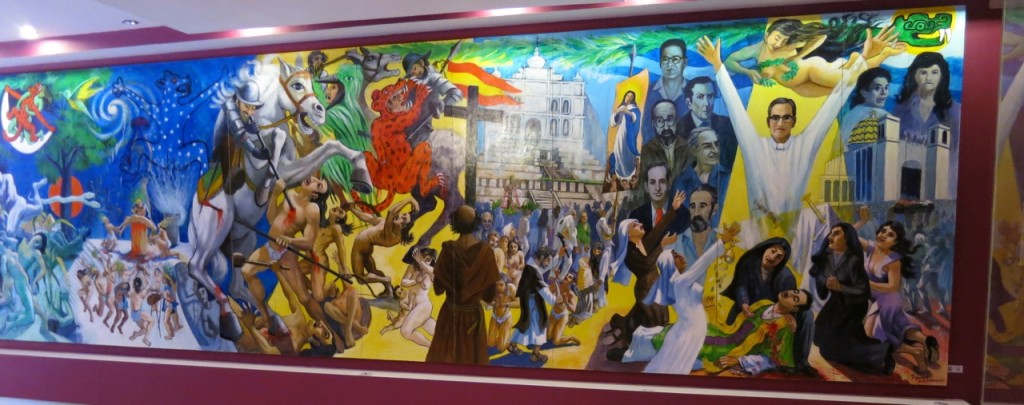From the MUNA Museum in San Salvador

Attached you will discover twenty mural photos that captured our attention while visiting El Salvador. The themes vary: some depict wildlife typical of the area – tropical birds and fish; many illustrate valued community themes such as worship, education, work, and relaxation; at least one reminds the viewers of a serious time in history.
Murals can be interior or exterior. In this collection attached all are exterior shots. Exterior murals can be painted using a variety of methods including rollers, brushes, spray, and airbrushes. A layer of varnish or acrylic glaze is then applied to protect the paint from the UV rays and surface damage.
The mural (from the Latin word murus meaning “wall”) is used as an effective graphic arts tool to communicate with the masses. Although popular in Latin America, the origin of murals dates back to 15,000 B.C. in France with cave murals as well as 1700 B.C. in the Far East. The National Society of Mural Painters, founded in 1895, refers to murals as “art for the public space.”
While many murals are painted on the side of a building by individuals, other murals are group projects. Some murals done on a long wall tell the story of a community’s history. In these cases a project coordinator organizes a team that could be composed of multi-generations of the community to participate. Artistic talent is overlooked; the emphasis is on affecting the participants involved in the mural. Sometimes making the mural is a cathartic experience designed to help the muralists heal. Examples are massacres or destructions of their community. These murals tend to provoke strong emotion in the viewer.
Often those Latin Americans who have migrated to the U.S. have carried their love of mural art with them. For many of them who feel disconnected in their new surroundings due to issues of economic and immigration crackdown, creating a mural can be a release and a way to bond with their new neighbors. In border communities Girl and Boy Scout troops have been part of mural making for this purpose.
Murals can be a canvas of expression for religious, political, environmental, and social issues. They can be influential in engaging in dialogue viewers whose views may differ. The bright colors in murals can show promise and hope. The overall effect of the work adds aesthetic value to an otherwise dull block wall and can help change attitudes of those viewing the mural.
Click here to view the murals: http://www.youtube.com/watch?v=OEsnNS6dAuk
This colorful outdoor artform is gaining recognition and acceptance in the field of art worldwide.


